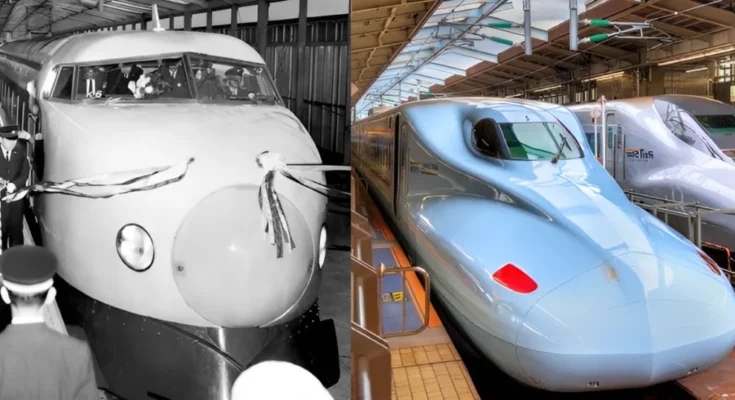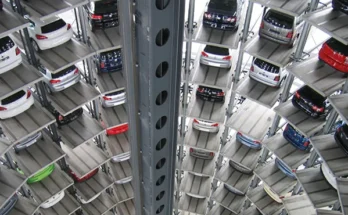The Shinkansen, Japan’s revolutionary bullet train, made history in 1964 as the world’s first high-speed rail system, boasting an initial speed of 210 km/h (130 mph). What started as a bold vision to modernize Japan’s railway infrastructure quickly became a global benchmark for high-speed travel.

Since then, high-speed rail technology has evolved dramatically, with new developments reaching speeds that were once thought impossible. Both Japan and China are at the forefront of magnetic levitation (Maglev) train technology, pushing the boundaries of speed and efficiency.
In 2015, Japan’s Maglev train shattered records, reaching a staggering 603 km/h (375 mph) during testing. Not to be outdone, China’s Qingdao CRCC 600 Maglev train, unveiled in 2021, is designed to operate at 600 km/h (373 mph). These ultra-fast trains are reshaping global transportation, promising safer, faster, and more energy-efficient travel than ever before.
The Shinkansen: How It All Started

The Shinkansen debuted in Japan on October 1, 1964, just in time for the Tokyo Olympics, symbolizing Japan’s post-war resurgence and technological dominance. Before its introduction, long-distance travel in Japan was slow and inefficient. The Shinkansen changed everything by:
- Reducing travel time between Tokyo and Osaka from six hours to just four
- Providing an ultra-smooth, safe, and efficient alternative to air and road travel
- Setting global standards for high-speed rail safety, with a remarkable zero passenger fatalities in over 50 years of operation
The Shinkansen not only revolutionized Japan’s infrastructure but also inspired countries worldwide to develop their own high-speed rail networks.
The Rise of Maglev: The Next Evolution in Speed

While traditional high-speed trains rely on wheels and tracks, Maglev (magnetic levitation) technology eliminates track friction, allowing trains to move at previously unimaginable speeds.
Maglev trains operate by using powerful electromagnets to lift the train above the tracks, eliminating physical contact and dramatically reducing resistance. The benefits of Maglev technology include:
- Unmatched Speed: Maglev trains reach speeds of over 600 km/h, reducing long-distance travel time significantly.
- Smoother Ride: With no physical contact between train and track, vibrations and noise are minimized.
- Higher Energy Efficiency: Maglev systems are more energy-efficient than traditional high-speed rail, making them an eco-friendly alternative.
- Lower Maintenance Costs: With fewer moving parts, Maglev trains require less maintenance than conventional trains.
Japan and China are leading the charge in Maglev innovation, each pushing the envelope in speed and design.
Japan’s Maglev: Breaking Speed Records
Japan’s SC Maglev (Superconducting Maglev) train project, operated by JR Central, is set to transform intercity travel. In 2015, this Maglev train set a world record, reaching 603 km/h (375 mph) on the Yamanashi Maglev Test Line.
Key Features of Japan’s Maglev Train:
- Uses superconducting magnets for ultra-smooth and stable levitation
- Designed for commercial operation at speeds up to 500 km/h (311 mph)
- Tokyo to Nagoya travel time will be reduced from 100 minutes to just 40 minutes!
The Chuo Shinkansen Maglev Line, set to open in 2027, will connect Tokyo, Nagoya, and later Osaka, cutting current travel times by more than half.
China’s Maglev Ambitions: The Qingdao CRRC 600

China is aggressively expanding its high-speed rail network and has taken a major step with the Qingdao CRCC 600 Maglev train, engineered for speeds of up to 600 km/h (373 mph).
Key Features of China’s Maglev Train:
- Developed by China Railway Rolling Stock Corporation (CRRC)
- Utilizes electromagnetic suspension technology to achieve ultra-high speeds
- Designed to fill the gap between conventional high-speed rail (350 km/h) and air travel
China’s goal is to create a seamless high-speed rail system that rivals air travel in efficiency, cost, and convenience. The Qingdao CRCC 600 Maglev is expected to reduce travel time between major cities significantly, making cross-country travel faster and more efficient.
How Do Japan and China’s Maglev Trains Compare?
| Feature | Japan’s SC Maglev | China’s Qingdao CRCC 600 |
|---|---|---|
| Max Speed | 603 km/h (375 mph) | 600 km/h (373 mph) |
| Operational Speed | 500 km/h (311 mph) | 600 km/h (373 mph) |
| Technology | Superconducting Maglev (SCM) | Electromagnetic Suspension (EMS) |
| Planned Route | Tokyo to Osaka (via Nagoya) | Major Chinese city routes |
| Commercial Launch | 2027 | Expected in the 2030s |
Both nations are pushing the limits of high-speed rail, but Japan’s SC Maglev has set the speed record, while China’s CRCC 600 aims to integrate Maglev into its massive high-speed rail network.
The Future of High-Speed Rail: What’s Next?

The rise of Maglev trains is just the beginning. Future innovations in high-speed rail could include:
- Hyperloop Systems: Vacuum tube transport that could push speeds beyond 1,000 km/h.
- AI-Controlled Rail Systems: Advanced automation for safer, more efficient operations.
- Sustainable Rail Technologies: Eco-friendly energy sources to reduce carbon footprints.
With nations competing to develop the fastest and most efficient transportation systems, the future of high-speed travel looks more promising than ever.
Final Thoughts
From the Shinkansen’s 210 km/h in 1964 to Japan and China’s Maglev trains exceeding 600 km/h, high-speed rail has transformed global travel. As technology advances, we may soon see trains that rival air travel in both speed and convenience.
The only question that remains: Which country will break the next speed record?



